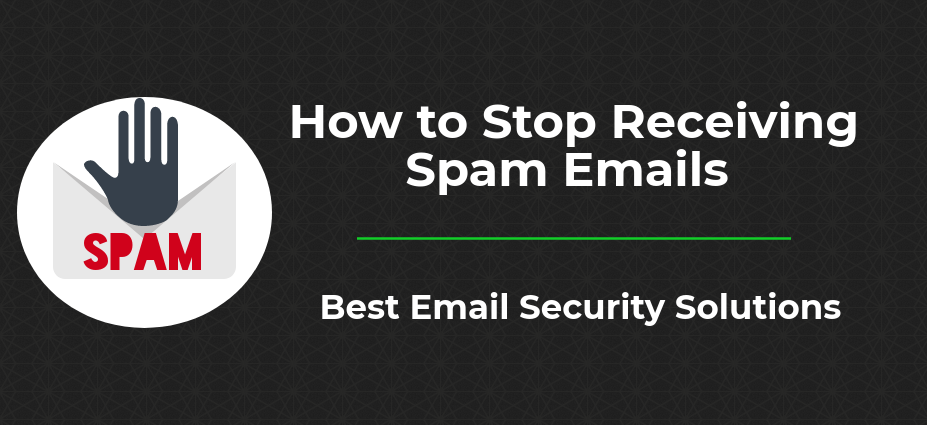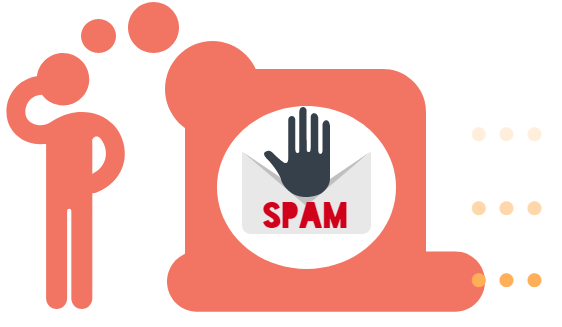How to Stop Receiving Spam Emails – Best Email Security Solutions

Contents

While technological advancements have opened doors for businesses around the world, there is also a significant downside we sometimes forget: creating dependency.
To exemplify, email is a critical business tool used by corporations around the world and without access to this useful means of communication, productivity and revenue can be negatively influenced.
Bearing this in mind, finding the adequate business email management tool to oversee emails is imperative, as numerous dangers can cause significant headaches – from system downtime and malicious data leaks, to compliance fines and infected computers.
 With over 70% of all emails incorporating actual spam and ads and with spam reports on the rise, finding the best email filtering service to block this from happening is a top priority. Additionally, if you don’t have a filtering service, you are potentially open to targeted attacks.
With over 70% of all emails incorporating actual spam and ads and with spam reports on the rise, finding the best email filtering service to block this from happening is a top priority. Additionally, if you don’t have a filtering service, you are potentially open to targeted attacks.
Moreover, even if you make a new email account, this will still not guarantee that you’re safe from threats and spam. So, to help you in your endeavors and guarantee the integrity of your email account, this article will discuss the different types of threats and how they can be stopped.
Solutions
Whether you’re looking for the best spam filter for email clients like Outlook, Opera Mail, Mozilla Thunderbird, Mailbird Lite we have selected a few enhanced email security services that are bound to give you peace of mind.
FVS Email Gateway Security
If you are looking to block email threats, protect your email address and sensitive information, or merely finding a service to generally block junk email, the FVS Email security maintenance service can efficiently detect suspicious word patterns.
Not only that, but it will also detect Trojans, viruses, phishing emails and even compliance violations concerning data leaks. With this solution, you will finally have an answer to your question: “How to stop junk email?”
The service offered by freevirtualservers.com comprises of seven encryption standards, including TLS, S/MIME, Secure Mail Encryption, OpenPGP, Voltage and PGP Universal.
The combination of these techniques is meant to ensure that messages can be delivered and received securely – in fact, without any end-user action.
Relying on leading global firms such as SpamExperts, you will be able to benefit for more than 99% spam-less accounts and email protection technologies. Featuring secure computing services, the FVS Email Gateway can offer you real-time analysis on more than 1/3 of all the globe’s traffic.
This quick and competent email solution can protect your account from over 99% of all malware.
Proofpoint
An alternative to FVS Email Gateway is Proofpoint, an email protection service designed to detect both non-malware and malware threats.
To better put things into perspective, we are discussing BECs, otherwise known as impostor emails, which take the shape of business correspondence.
Behind the service, there is the cloud-based email security, or the option to deploy the security measures on the premises of your business.
It provides granular filtering to control bulk “graymail,” along with any other spam emails which may hinder the overall performance capabilities of your business.
Moreover, Proofpoint can keep email communications flowing between enterprises, regardless of whether the email server fails or not.
Symantec
Should you be seeking an email spam filtering service capable of protecting both you and other users from cyber-attacks, Symantec might be a great place to start.
Capable of delivering accurate email security that is reliable and tailored to your individual needs, this company prides itself on efficiently protecting users from targeted attacks.
The service makes use of self-learning capabilities, with the system designed to focus on email security. Supporting Microsoft Office 365, Google Apps and other Microsoft services, Symantec is an accurate and dynamic way to prevent the loss of sensitive data.
Cisco
Cisco Email Security is designed to protect businesses from spoofing, ransomware, email compromise and even phishing.
In fact, by using a multilayered approach and advanced threat intelligence software, Cisco is a valuable service to use when concerned about both inbound and outbound data loses.
Typical Problems
Ransomware
 According to recent reports released by eWeek, approximately 2 to 4% of all emails contain malware issues, a false positive, or spam messages. To better put things into perspective, this means that a staggering 6 million viruses are sent out every single day.
According to recent reports released by eWeek, approximately 2 to 4% of all emails contain malware issues, a false positive, or spam messages. To better put things into perspective, this means that a staggering 6 million viruses are sent out every single day.
One common malware problem encountered around the globe is ransomware – a type of virus that limits access to your computer, including files, videos and pictures. In turn, you may see that a pop-out will demand payment for the release of certain documents.
Phishing
 The concept of phishing involves using psychological manipulation for making users divulge sensitive information, which can then be sold for malicious and criminal activities.
The concept of phishing involves using psychological manipulation for making users divulge sensitive information, which can then be sold for malicious and criminal activities.
A phishing attack can be typically identified by an authentic-looking email which reports that you need to change passwords to keep your computer safe.
Other phishing techniques involve infected attachments (i.e., a bt phishing email, a fake iTunes email), or links which can procure your personal data.
This may remind you of a scandal involving Apple users from a while back, where Apple fraud email and Apple ID email scam issues were all over the news.
By using particular words or a fake Apple invoice email, cybercriminals gained access to the network and stole a plethora of information from unsuspecting users of the service.
Man-in-the-Middle Attacks
Having a secure email or password doesn’t seem to suffice these days. While email encryption adds an additional layer of security, cybercriminals can often insert themselves between the user and the application, service, or even a web link, which the victim is using.
By using this process, your account is merely an email host through which the attacker can impersonate you – reading emails, responding as you would and stealing sensitive information concerning transactions.
Needless to say, without a proper email migration and email filtering service set in place, a spam message, a junk email, or even accidental data leaks can quickly occur. In some cases, this can cause irreparable damage to your business.
Similar to other malicious threats, man-in-the-middle attacks have a high spam capture rate and have been around for many years.
While an unwanted email is easy to avoid, this type of sneaky malware doesn’t require expensive hacking tools, making it widely available for criminals around the world.
Spoofing
Due to the fact that email protocols don’t use adequate mechanisms and techniques for detecting and regulating email addresses, hackers can more efficiently use domains and create fake addresses.
Moreover, these are so similar to the legitimate email that it’s hard to identify them with the naked eye. The result of spoofing is deceiving victims into believing that the emails received are from trusted individuals they deal with on a daily basis.
Some even go one step further, spoofing business mailboxes for a similar-looking, fake one (i.e., jbloggs@abccompany vs. jbloggs@abcompany). Thus, you must always check recipient to make sure that you’re emailing the right person.
Spear Phishing

According to the SANS Institute, a staggering 95% of all data breaches have one thing in common: spear phishing.
Despite enterprises around the world embracing anti-virus and spam-free services, it still appears that a large number of malware avoid detection from regular spam filters an individual or a firm might set in place.
When it comes to learning more about spear phishing, it’s essential to note that merely a tiny percentage of individuals are targeted. Moreover, a considerable amount of research and effort actually goes into making all emails genuine and legitimate-looking.
But what makes them able to continue down this path is taking advantage of zero-day vulnerabilities, which are not typically detectable using conventional anti-malware tools.
To avoid becoming a victim, an intuitive way is to add security layers – creating a multi-scanning device designed to increase protection against both known and unknown threats.
Conclusion
The answer to the question “How to stop spam emails?” might not appear as simple as it once were. Although these days a big selection of security systems can detect threats to your data and safety, not all of them are created equal.
Today’s advanced email threats have changed, adapting to our ever-evolving technologies and designing advanced email threats that are mainly intended to fool legacy sandboxes, SEGs and other conventional security systems.
In the process of detecting and preventing your personal and work computer from malicious emails, people and organizations must augment their security measures, deploying services capable of performing and delivering accurate, thorough content inspections.
By performing these steps, you will be able to understand the full context of a situation or malware threat, while enabling security analysts to make informed and precise decisions for the sake of your company. Lastly, more than anything, make sure you have a secure email gateway.







